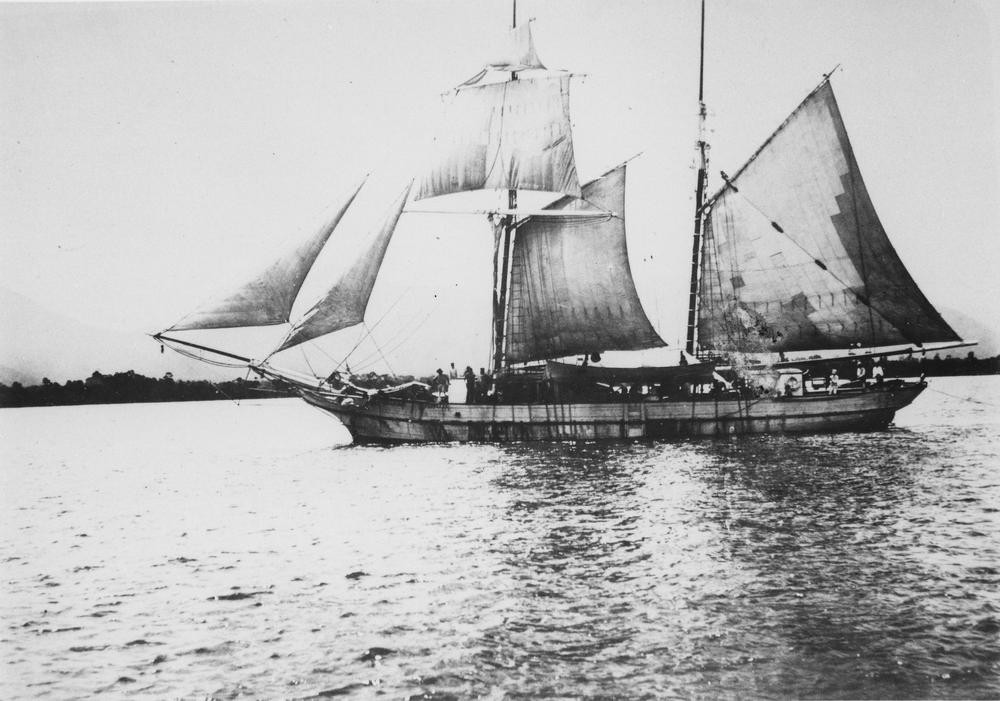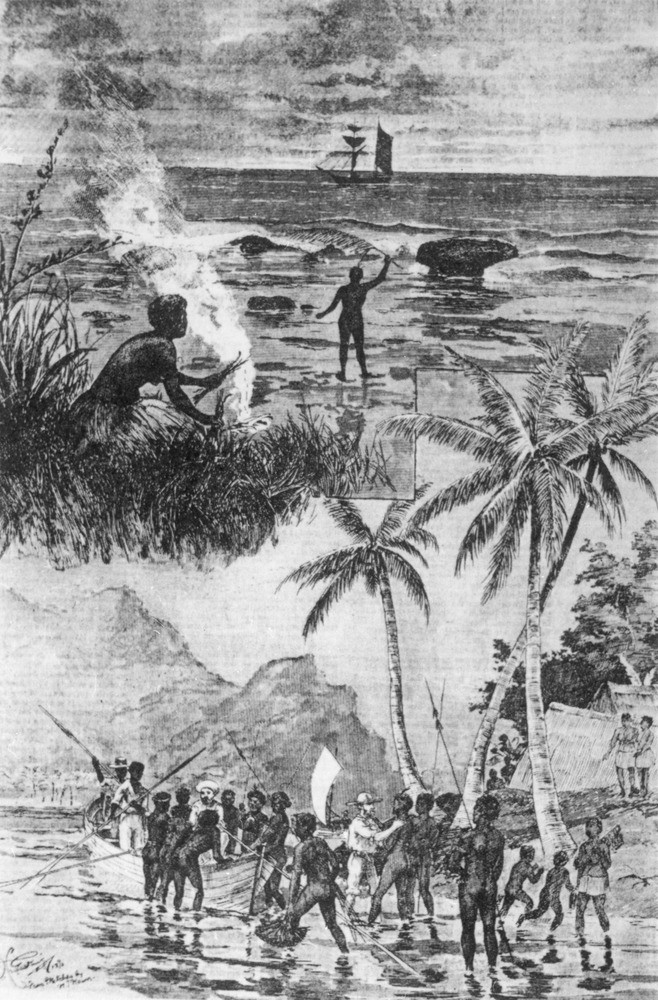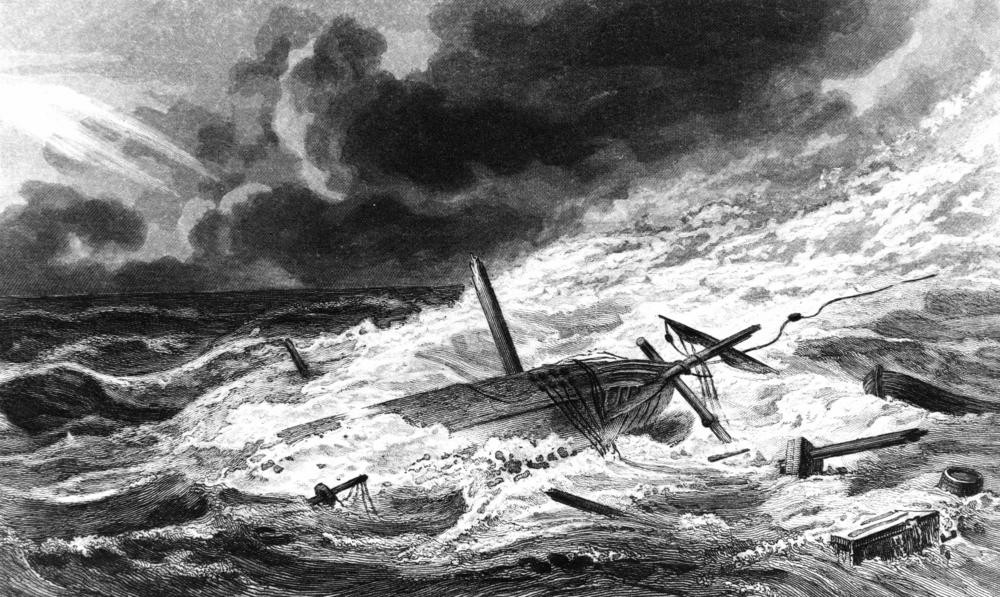Bully Hayes - Pacific pirate : truth or fiction?
By Simon Miller, Library Technician, State Library of Queensland | 12 September 2013
September is here again and International Talk Like a Pirate day is almost upon us. I, for one, will be polishing up my wooden leg and practicing the three aaarrrrrghs for the occasion and raising a few doubloons for Childhood Cancer Support. Last year I dug up a story about escaped convicts capturing a ship in Moreton Bay. This year I bring you the story of the man sometimes known as the last of the Pacific pirates, Bully Hayes.
William Henry Hayes was a notorious American sea-captain who wandered the Pacific Ocean from the 1850s to the 1870s. Known universally as Bully Hayes, his reputation as "Barrator, Bigamist, Buccaneer, Blackbirder and Pirate" as subtitled by A.T. Saunders in his book about Hayes, is largely based on unreliable and largely fictitious accounts. In particular, Hayes notoriety began with the work of Australian author Louis Becke, who had sailed with Bully Hayes, although not as extensively as he claimed. Becke, who's real name was George Lewis Becke, is a very unreliable witness and his own character was less than exemplary. Becke spent time in Queensland in the 1870s and 1880s, joining the Palmer River Gold rush before working at Ravenswood station and then as a bank clerk in Townsville in 1878-1879 before going trading in the Pacific islands. Becke was in Sydney in the 1890s when he turned to writing, drawing on his Pacific experiences to write adventure stories for the the Bulletin. He went on to write 34 books including thirteen novels. His collection of short stories Bully Hayes : Buccaneer and other stories was published in 1913 with illustrations by Norman Lindsay.
Perhaps the most reliable account of the life of Bully Hayes is Captain Bully Hayes : blackbirder and bigamist by Frank Clune although he includes the disclaimer "This book may be classed as fiction because it includes numerous yarns about the career of Bully Hayes that cannot be verified." Clune tells us that Hayes was born in 1829 in Cleveland, Ohio, on Lake Erie. He began his sailing career on the great lakes, working for his father until he was eighteen. He developed into "a powerfully built man, six feet tall, weighing over two hundred pounds in his prime, with piercing blue eyes, reddish-brown hair and beard, a pleasant baritone singing voice, and charming gentlemanly manners. And he could fight like a threshing machine!" He learnt his sea craft in down-easters, voyaging round Cape Horn to California. Whatever else is said about Hayes, he was certainly an expert sailor.
Hayes may, or may not, deserve being described as a pirate but he was certainly a swindler. He generally had no difficulty obtaining a ship when he had lost his previous vessel, either wrecked or reclaimed by creditors. His usual method was to persuade somebody to go into partnership with him, signing over a mortgage on the ship in return for his partner paying the bulk of the purchase price. He would then sail off and his partner would see neither ship, nor money again. He would usually get his new ship refitted and stocked with provisions and often loaded with cargo and then neglect to pay his bills before disappearing over the horizon. He left a string of bad debts from San Francisco to Shanghai, to New Zealand and Sydney, Melbourne and Adelaide.
Hayes also had wives in various ports, including Adelaide widow, Amelia Littleton who Hayes settled in San Francisco. He acquired another wife, Rosa Buckingham, while running a hotel in Dunstan on the New Zealand goldfields. Rosa and their infant daughter Adalaida were drowned when a yacht that Hayes had borrowed was capsized in a sudden squall. Hayes then married Emily Butler in Christchurch who he took to live at Apia in Samoa where he made his Pacific base. In between visits to his wives Bully Hayes was seldom without female companionship in his travels, either charming young native girls to sail with him or pressuring island chiefs to provide him with girls as well as coconuts. There are also reports, possibly vindictive, that Hayes was guilty of the rape of girls as young as ten but it seems that for the most part his companions were willing enough.

South Seas Islander labour schooner called the Fearless - Bully Hayes commanded several similar vessels
Bully Hayes was certainly engaged from time to time in 'Blackbirding', or trading in native laborers taken aboard by trickery or force, and delivered to work on plantations in Fiji. It doesn't appear that Hayes was involved in shipping laborers to Queensland. It seems that Hayes only occasionally took to blackbirding, his usual business being trading in copra and coconut oil. There are a couple of recorded instances in 1868 and 1869. In 1868 the British Consul in Tahiti recorded "There has been introduced by the brig Rona of Lyttlton, W. H. Hayes, master, about 150 natives of Savage Island under contract for service, who have not, to my knowledge, complained of having been deceived in their engagement or ill-treated during the voyage hither." Some nine months later, the Rona having sunk in the meantime after her leaking hull overtook the capacity of the pumps, Hayes was commissioned by one Frederick Henry Severight to procure laborers for planters on the Fiji Islands. He leased the schooner Atlantic and a few weeks later arrived at Manihiki, a Pacific atol north of Rarotonga. Hayes discovered that the islanders were anxious to visit a neighbouring island and offered passage, suggesting that the whole settlement should go but in the end only the men were persuaded to go. Once they had sailed Hayes told them that they were going to Fiji instead. He carried out a similar deception on another island before arriving at Pago Pago in Samoa. Here his plans came undone when he sent the islanders ashore to wash their clothes but they escaped and Hayes found himself held captive by the local chief.

Image of a drawing showing the forced recruitment of South Sea Islanders to work on the plantations in Queensland, 1892
Consequently Hayes found himself back at Apia subject to an inquiry by the British Consul, Mr Williams. Williams concluded that Hayes was guilty of the charges brought against him and was preparing to send him to Sydney where they would have more authority to deal with the case. In the meantime, however, another rogue, one Ben Pease had arrived on the brig Pioneer and Hayes, persuading the consul that his chronometers needed checking, was allowed to go aboard and promptly sailed away.
Hayes and Ben Pease sailed to China. By all reports Pease was an even worse character than Hayes. The Pioneer was quite heavily armed as a defense against pirates in the China Seas but Pease also reportedly used the ship's guns to take goods and laborers by force. It is possible that some of the buccaneering reputation of Pease became attached to Bully Hayes. In any case it seems that Pease got himself arrested in Shanghai and Hayes claimed the Pioneer for himself and renamed her Leonora. With the Leonora Hayes established a successful chain of trading stations in the Line Islands and in 1874 Louis Becke sailed with Hayes for a little under two months. Becke would later claim that he had been employed as supercargo on the Leonora for nearly four years and it was this claim that gave credibility to the largely imaginary stories that Becke later told about Hayes. It is true that Beck was aboard the Leonora when the ship was wrecked after a storm blew up when they were anchored in a lagoon. With no chance of raising sail and escaping the lagoon the ship dragged its anchor and was driven on the reef and wrecked. The wreck is dramatically described by Becke in Bully Hayes : buccaneer.
Hardly had the second gust passed away when the full strength of the gale was upon us with a droning hum, and we knew that unless our stern hawsers held there was no hope for the ship. In less than twenty minutes the wind had increased to hurricane force, and the brig was thrown almost on her beam ends for some minutes, and then the stern hawsers parted one after the other ; the brig spun round like a top, and came head to the wind on her short length of cable, with the roaring breakers on the reef less than fifty yards from her stern. She held on for a time.
The noise of the wind almost drowned the sound of Hayes's voice as he thundered out his orders. "There is no hope for us," he shouted in my ear ; "go below and secure the ship's papers, chronometers, and cash."
I hurried below into the well-lit cabin, and with the help of the steward and a half-caste girl named Lalia, the wife of a trader, got everything together, in one of the boats. Just as I got on deck the cable parted, and the brig struck stern first with a crash on the reef, tearing away her rudder and smashing the stern post. ...
Presently a tremendous see lifted the ship high up and hove her broadside on to the reef - a few feet from the edge - where she lay on her port side for a few minutes, giving those on board barely time to get into the longboat, which, in charge of the second mate, was breasting the surf in deep water. Hayes, the mate, steward, two of the traders, six seamen and myself tumbled into her when she backed in, and before we could realise it we were lifted up by a sea and swept over the inner reef into comparative safety, as a mountainous roller buried the Leonora up to her tops. As the backwash swept seaward again it carried her with it, and, rolling off the reef, she sank under its very ledge.

Artists impression of a shipwreck (Stirling Castle)
Hayes, Becke and the crew were stranded on the island, Kusaii or Strong's Island, for six months, spending the time productively making a large store of coconut oil. Then three ships arrived, a German trader, a missionary ship and, unluckily for Hayes, H.M.S. Rosario of the British Navy. The British officer, Commander Dupuis, was reluctant to arrest Hayes, an American, without direct evidence of wrongdoing but when the missionary persuaded the island chief to make a complaint against Hayes he proposed taking Hayes to Sydney to face an inquiry. Hayes, deciding to avoid the inconvenience, sailed off in a small boat with one other sailor, trusting Louis Becke to look after his affairs and property on the island. His trust was misplaced and Becke promptly handed all the documents Hayes had given him to the British Commander and asked to be taken to Sydney as a castaway.
Hayes, meanwhile, sailed his small boat to Guam where he managed to obtain another ship, the schooner Arabia. Rather than sailing away at once to reclaim his trading assets, however, Hayes stayed in the vicinity of Guam for some days until, going ashore for a swim on the beach, he was arrested by Spanish soldiers for helping some political prisoners to escape. When the soldiers launched a boat to search the schooner she promptly sailed away, the prisoners already on board making the best of the situation. Hayes had lost his newly acquired ship and was sent off to prison in Manilla. After nine months in prison and an ostentatious conversion to Catholicism Hayes was released and put on a ship to San Francisco. Now destitute, although still having large assets in his trading stations in the Pacific islands if he could reclaim them, Hayes agreed to navigate the yacht Lotus to the islands with the owner and his wife as passengers and two crew. Somehow the yachts owner stayed behind while the wife sailed off with Hayes.
The crew consisted of the mate and a cook and spare-time seaman, Peter Radeck, a Norwegian known as Dutch Pete. Hayes undoubtably bullied the cook, who objected to being called away from the galley to adjust the sails or take a turn on the tiller. Frank Clune notes that Dutch Pete could have left the ship when they stopped in Hawaii if he objected to his treatment by Hayes but did not do so. Hayes sailed to Apia, where according to the account of the mate Charles Elson, "the people received Hayes like some prince come home from foreign lands. The American Consul, the Captain of the Port and officials generally came to greet him." Elson also records that on the voyage from Hawaii to Apia, Hayes had thrashed Dutch Pete for refusing orders. He had knocked the Norwegian down with a punch to the face.
The yacht set sail again with the intention of visiting his trading stations, which had apparently been managed by his son Fred Hayes during his absence. They visited a number of islands where Elson reports "The greetings the natives gave him caused me astonishment. Despite the fact that Hayes was noted among them as a harsh and cruel man, they manifested invariably the utmost delight over his appearance." After leaving Jaluit Island, where they dropped off a passenger, Doctor Ingolls, the yacht was sailing through a storm at night. The mate had retired for a few hours sleep before taking his watch and Hayes and Pete were on deck. The mates report of what happened was published in the San Francisco Post.
The Captain spoke to the man at the tiller - who was cook and seaman - about his steering. Some altercation followed, and the Captain went below. When he came up the companionway some time after, the man let go the tiller and struck Captain Hayes on the head with the crutch belonging to the main boom. He fell and immediately expired. No firearms of any kind were found on him. The acting-mate at the time was below sleeping. The vessel returned to Jaluit as soon as possible. The Captain was buried at sea.
Later versions of the events were embroidered and exagerated, suggesting that Hayes was shot and drowned, and possibly eaten by sharks as well as being brained. Dutch Pete was never put on trial, as there was no competent jurisdiction in the Marshall Islands to apprehend him. Bully Hayes was murdered in March 1877, he was 47 years old.
Simon Miller – Library Technician, State Library of Queensland
Comments
Your email address will not be published.
We welcome relevant, respectful comments.